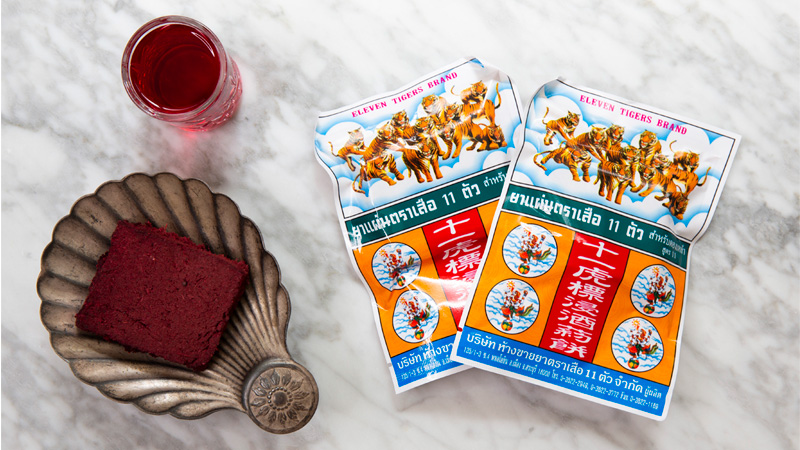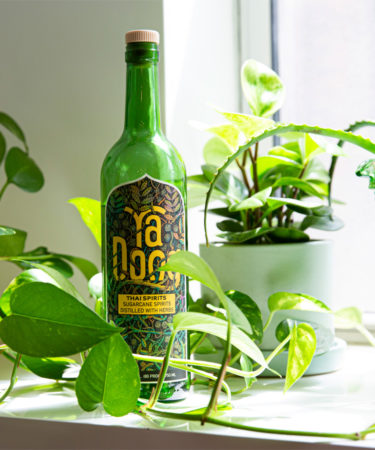Boong Boonnak gulped back his first shot of ya dong at 17 to commemorate his high school graduation. He grew up in Thailand’s Phetchabun province, about four-and-a-half hours north of Bangkok, and one of his friends’ fathers ran a ya dong stand in front of the family home.
Ya dong is a working-class drink, and it’s potent stuff, made by infusing inexpensive lao khao, or rice whiskey, with native botanicals.
“It’s cheap, house-brewed alcohol, kind of like moonshine,” says Boonnak, who’s now the owner and principal bartender at Boston’s Mahaniyom, one of the few restaurants in America that sells ya dong. “Back home, farmers and laborers would hang out and drink ya dong at the end of the day.”
Not unlike Italian amari, for most of its history, ya dong was sold as an herbal remedy. Its name (ยา ดอง) literally means pickled medicine, and its devotees believe it enhances blood flow and libido.
Ya dong’s nomenclature follows suit. There are varieties named kamlung seua khrong (strength of a Bengal tiger), naree rumphueng (groaning lady), and mah gra tueb rong (horse trampling). Boonnak’s inaugural shot was doh mai roo lom (ever standing), which refers both to the purported physical effect and the name of the primary plant that flavors the elixir.
“All the names are about sexuality and eroticism,” says Boonnak.
Ya Dong Meets Cocktail Culture
In 2015, ya dong made a significant leap from lowbrow to highbrow when Asawin Rojmethatawee opened Tep Bar in Bangkok. Tep Bar’s premise is based on sharing the traditional spirits, drinks, and culture of Thailand. “Before we opened, I traveled around the country and talked to farmers about how they drank in the old days,” says Rojmethatawee. “Ya dong, for a long time, was more like a prescription used for libido, but people also used it to celebrate.”
Rojmethatawee worked with an herbalist to develop three ya dong formulas, and his team infuses the botanical blends into premium rice whiskey and adds a touch of wild honey to take the edge off. Tep’s guests drink shots straight up or incorporated into cocktails.
“We were the first bar ever to serve ya dong,” says Rojmethatawee. “Normally, you get it on the street, and it’s very dodgy.”
Technically, street ya dong is illegal in Thailand, though you can still find vendors selling it in markets. The drink was banned after a few people died from consuming ya dong laced with toad venom, and Boonnak says it’s not unheard of for vendors to add scorpions, lizards, or snakes to their infusions.
Ya Dong in America
A visit to Tep Bar inspired Boonnak to bring ya dong back to the States, and, at Mahaniyom, he serves shots with a traditional set of chasers: pandan water, sweet-sour pickles, chili powder, and salt. He also incorporates ya dong into Daiquiris (made with 2 ounces Eleven Tigers, ¾ ounce pandan syrup, and ¾ ounce lime) and drops ya dong into glasses of Leo beer to make ya dong bombs.
The character of ya dong relies on botanicals native to Thailand and East Asia, so Boonnak imports four ya dong blends that he infuses into various base spirits. He can’t get lao khao in America, and he prefers more refined spirits anyway. “You can infuse the botanicals into any alcohol,” says Boonak. Lady Falling Off the Bed and Eleven Tigers are made with white rum. The Sobbing Sister-in-Law has a rye base, and a fourth ya dong, with an impolite name, is made with vodka.
Making Ya Dong at Home
Boonnak says you can readily find the ya dong blends at “at any night market in Thailand,” but Eleven Tigers, the mildest and sweetest of the four, is the only blend available in the States. Its ingredients include Betula alnoides, Elephantopus scaber, Kaempferia parviflora, Panax ginseng, Rauvolfia serpentina, Eucommia ulmoides, Anaxagorea luzonensis, Angelica sinensis, and Salvia miltiorrhiza.
To make it at home, simply drop the contents of an Eleven Tigers packet into a bottle of booze, and let it infuse for two to four days. The resulting infusion is beet-juice crimson and tastes like an earthy, sweet, and gently bitter adult licorice. Eleven Tigers is ready-made for refreshing highballs, and with its anise profile, it also makes an interesting rinse on a Sazerac.

Despite its proximity to amari, as well as the proliferation of Thai restaurants and bar programs in the States, ya dong hasn’t been widely explored or embraced by American bartenders. One notable exception is Uncle Boon’s in New York City. The restaurant is currently closed but has long offered $5 ya dong shots and a ya dong Boilermaker. Ya dong scarcity is partly a class issue. Most Thais who emigrate to America are professionals and students who are likely to associate ya dong with lower-class social status.
The Distilled Essence of Ya Dong
On his first visit to Thailand, Trip Sandifer had no preconceived notions of ya dong. He drank it on the streets of Bangkok, followed by more rounds at Tep Bar. Sandifer is the head bartender of The Painted Pin in Atlanta, and at the time, he and his business partner, Noah Kaufman, were traveling through Thailand and looking for a spirit to import to the United States. They had hoped to find an agricole-style rum to bring home but became enamored with ya dong instead.
Sandifer and Kaufman began working with Lamoon Lamai, a rum distillery in the southern Surin province of Thailand. Lamoon Lamai is owned by Kaustav Bagchi. His wife, Yok Na Montason, inherited a ya dong recipe from her grandfather, who sold the drink as a roadside vendor. The couple took the family’s ya dong botanical blend, which includes ginseng, Chinese angelica root, makrut lime, cinnamon, and green peppercorn, and infused it into a distillate of 90 percent fresh-pressed cane juice and 10 percent honey.
Sandifer says the resulting ya dong was delicious — especially layered on top of a premium rum — but Bagchi broke some bad news: Thai liquor laws only allow distillers to export clear spirits.
“We went through all these possibilities, and Kaustav suggested we make ya dong and then redistill it, so it’s more like a gin,” says Sandifer. “It was a random experiment, but it turned out really cool. It’s not exactly ya dong, but it’s the distilled essence.”
The first bottles of the product, simply named Ya Dong, hit the Atlanta market in late 2019. Though some of the aromas and tasting notes overlap, drunk side by side with Eleven Tigers, Sandifer’s Ya Dong is much more subtle, and he says it’s well suited for gin applications (think: ya dong Martinis), along with Daiquiris and “killer” rum tonics.
Right now, he and Kaufman can only distribute the spirit in Georgia, but they hope to expand their reach after Covid-19 subsidies and bar business (hopefully) returns to normal.
“We’ve had a couple of Thai restaurants pick it up, but the hardest sell has been the Thai community, I think because it has this lower-class connotation,” Sandifer says. “But ya dong has history. The recipe comes from a Thai grandfather, and it’s not made with a garbage spirit.”
For Boonnak, sharing ya dong means connecting guests with his rural roots — even if that means including sexually explicit language on his bar menu. “It’s about the culture for me. In Thailand, we have all these herbs and ingredients, and we need to become more famous for them — in the same way that European countries and even China celebrate their food and drinks,” he says. “The Thai government is focused on making ya dong illegal instead of telling its story. Ya dong isn’t cool in Thailand. But it should be.”
